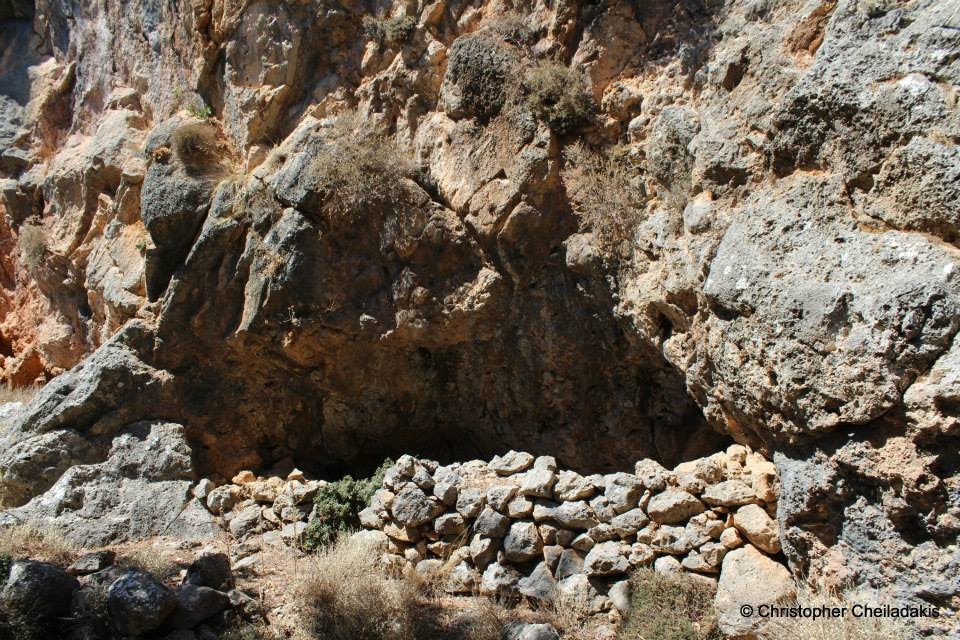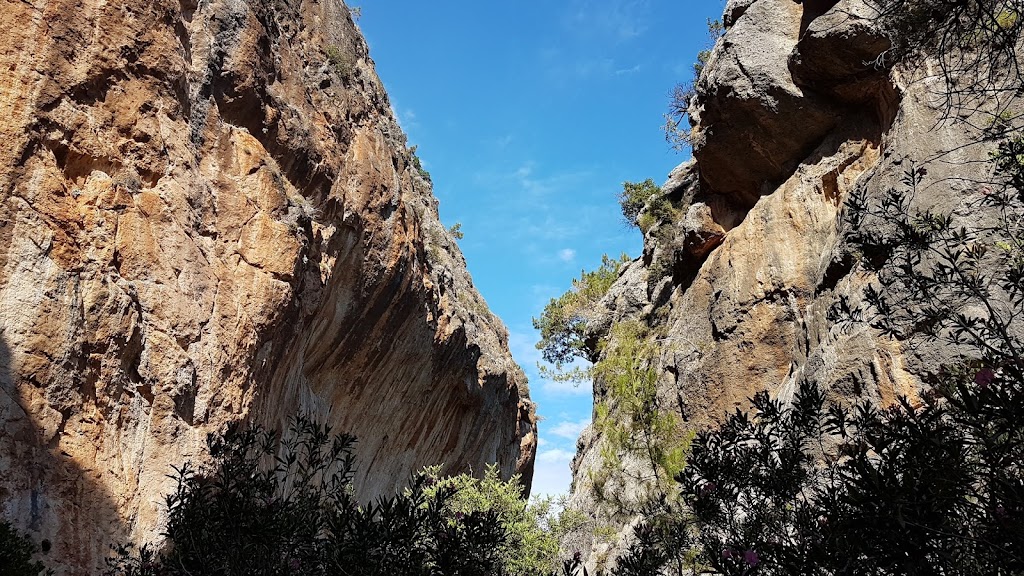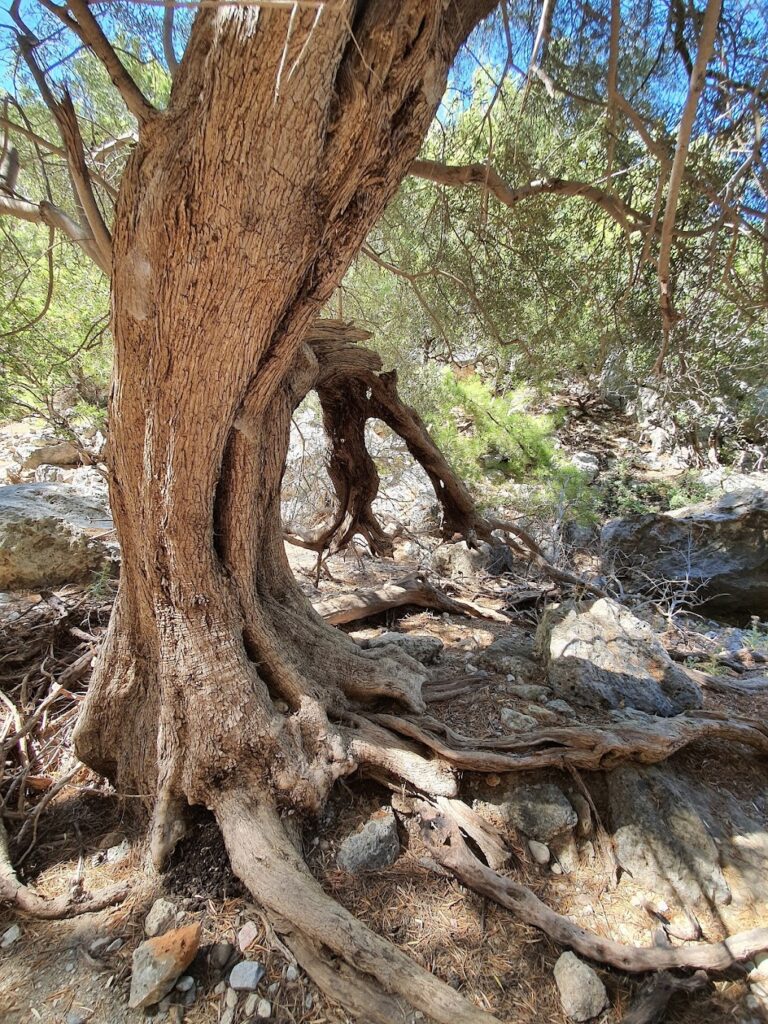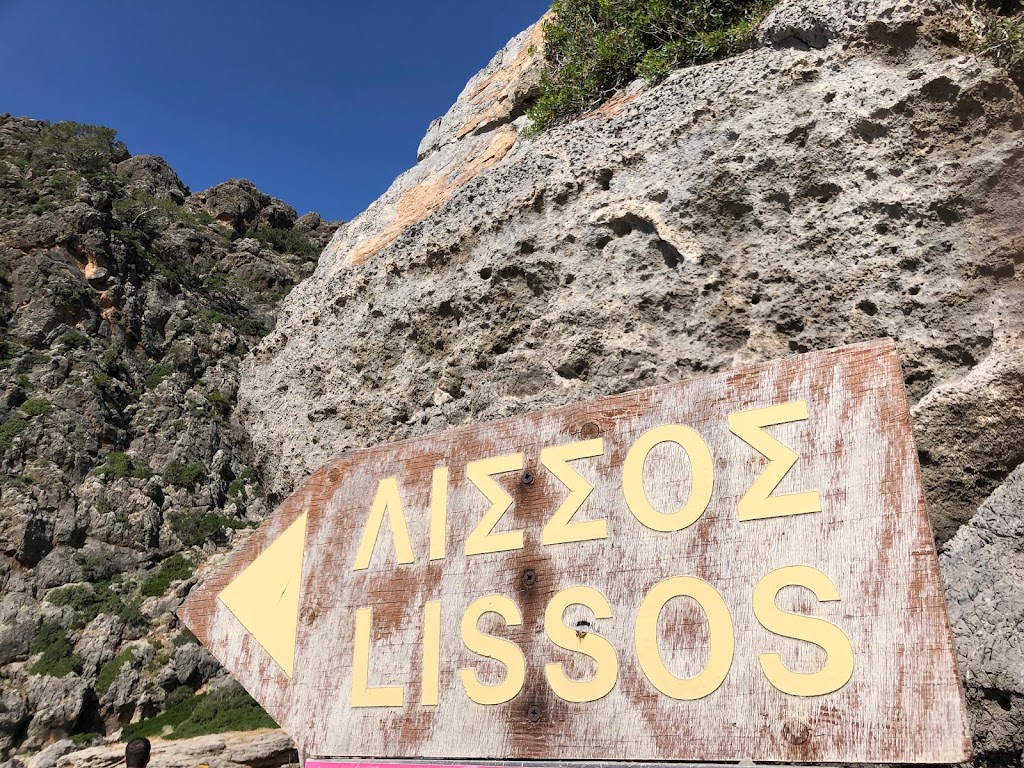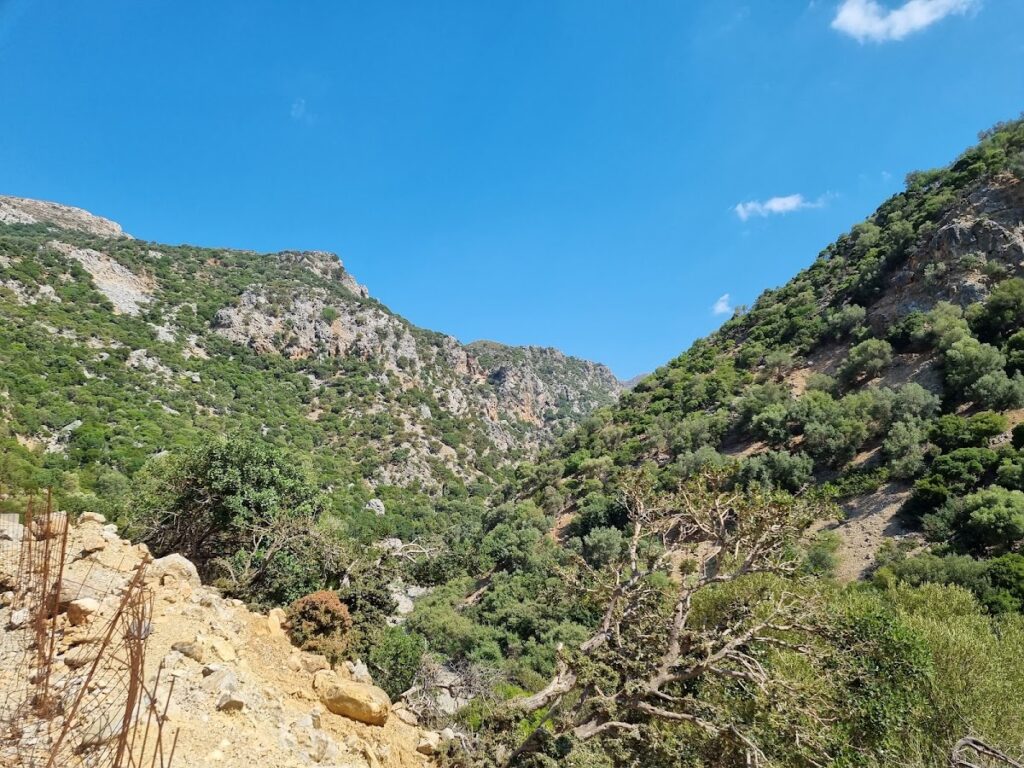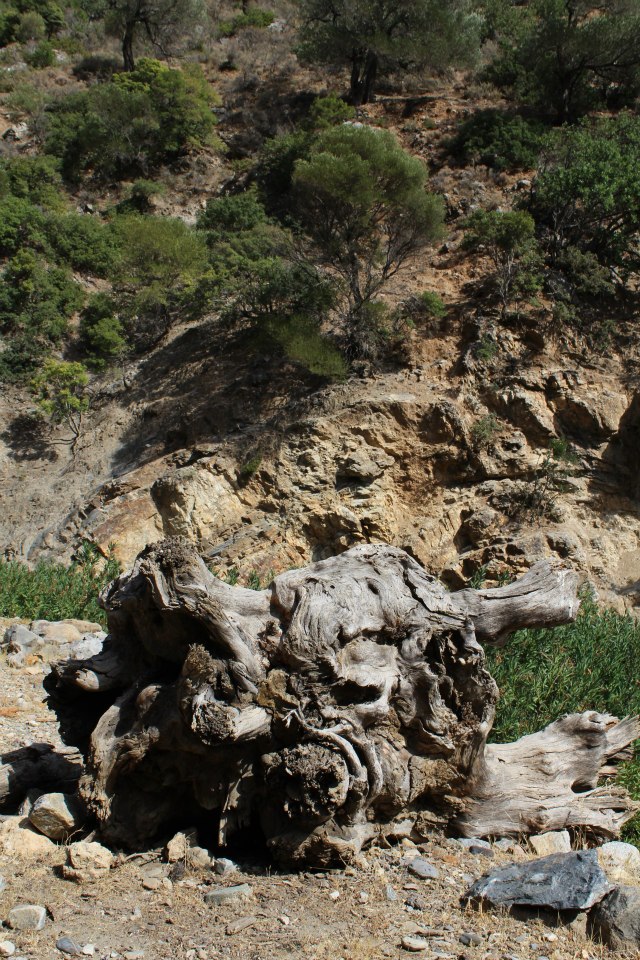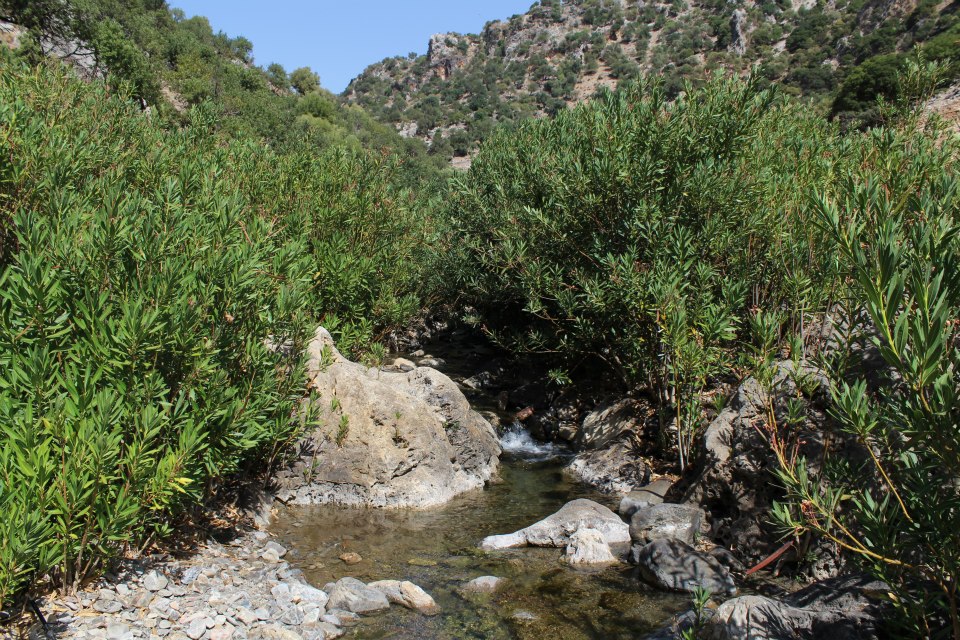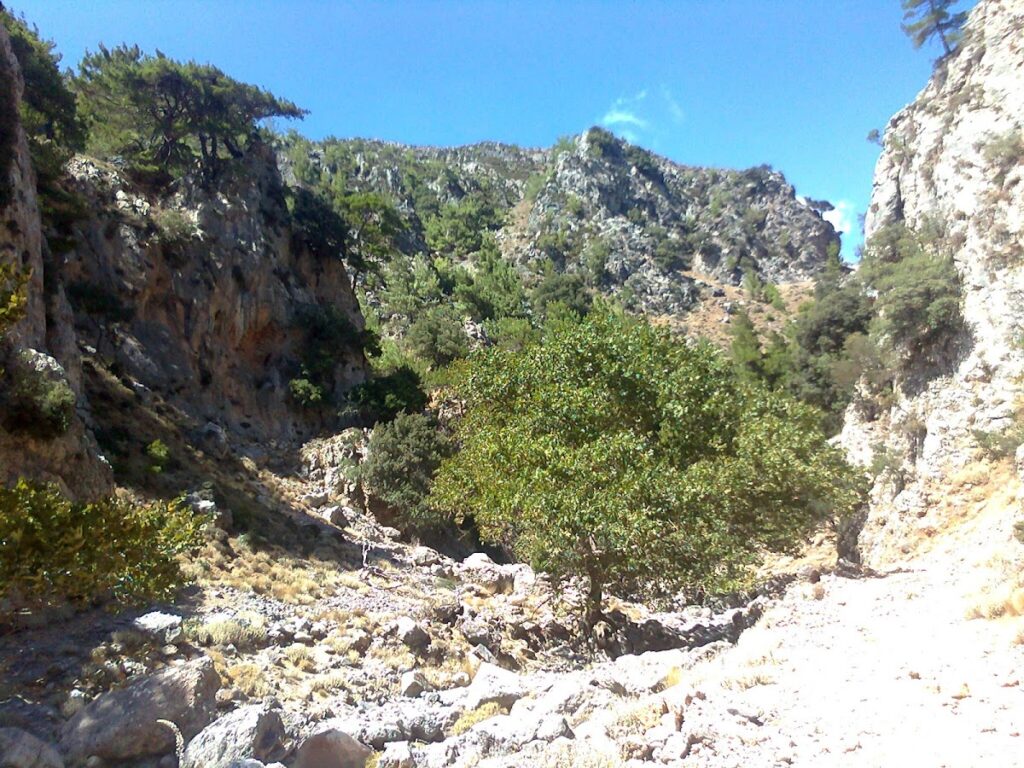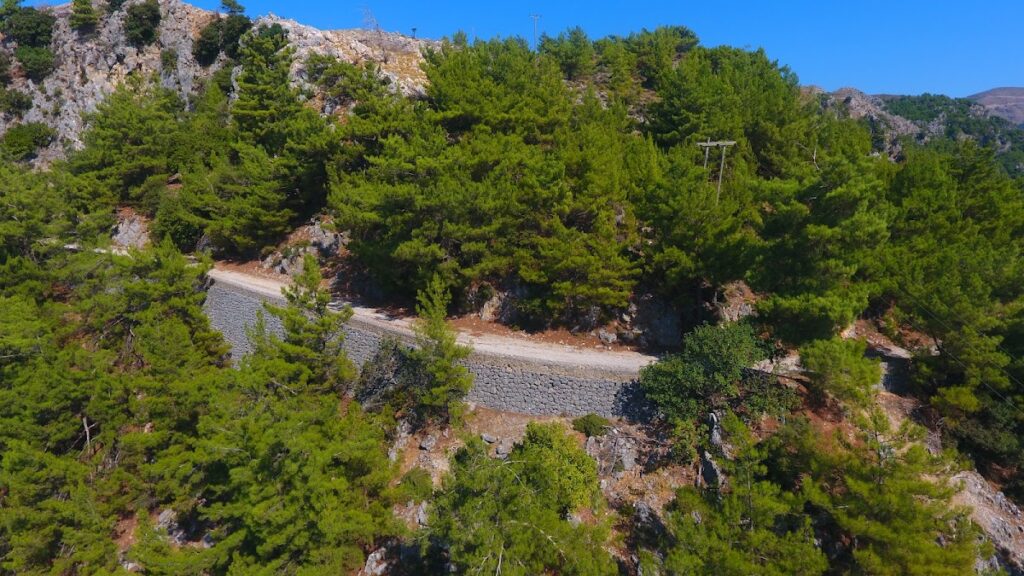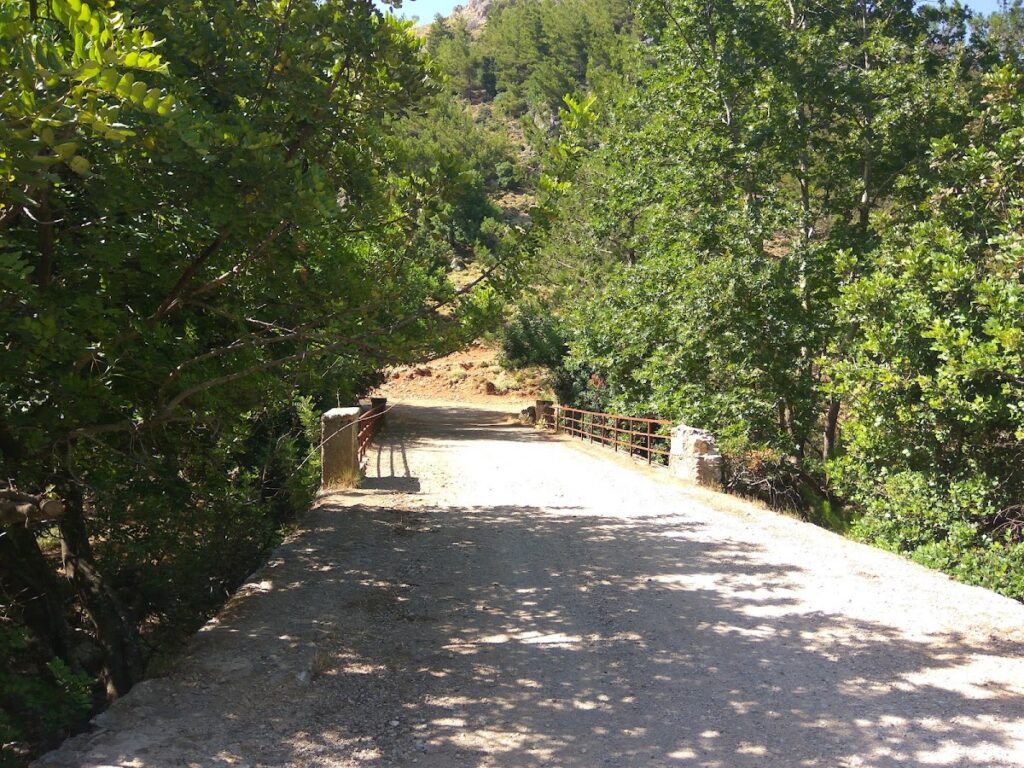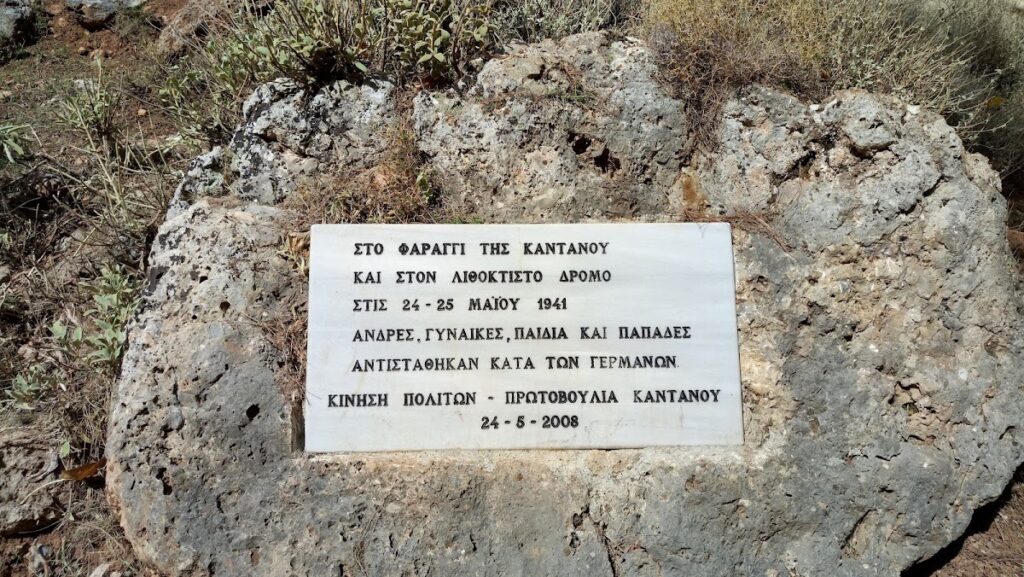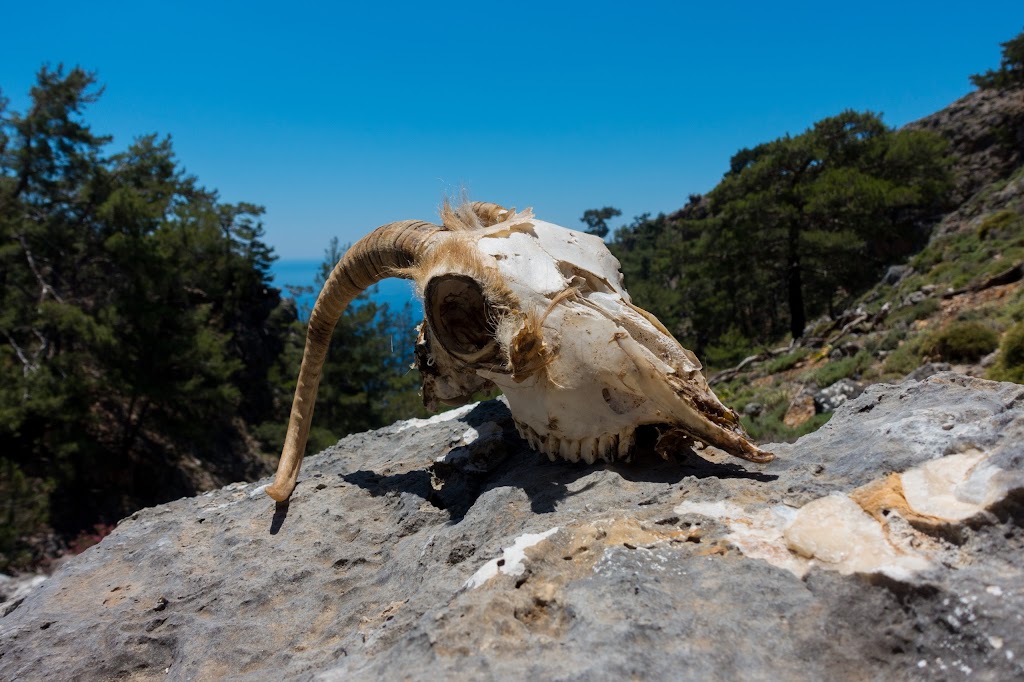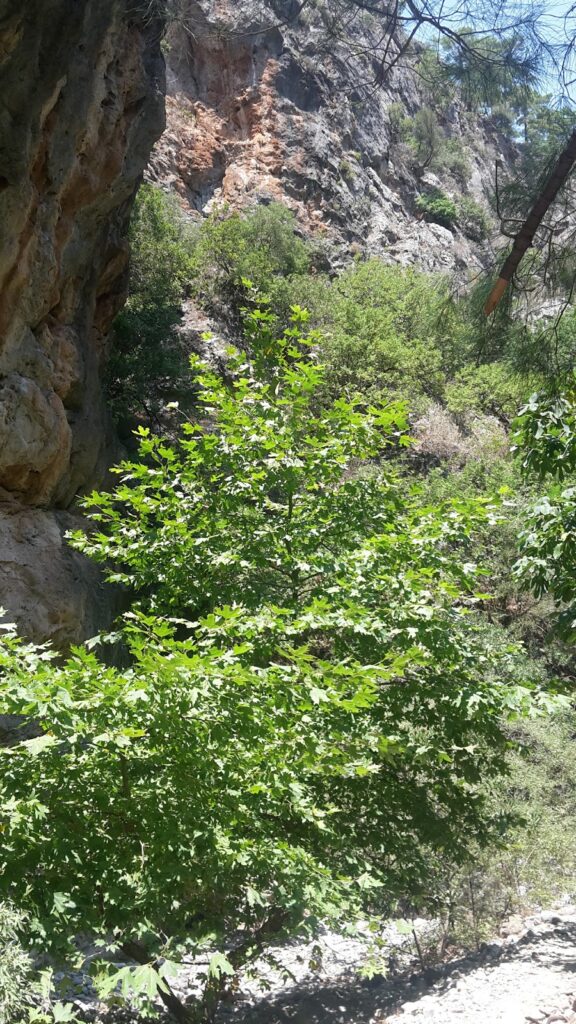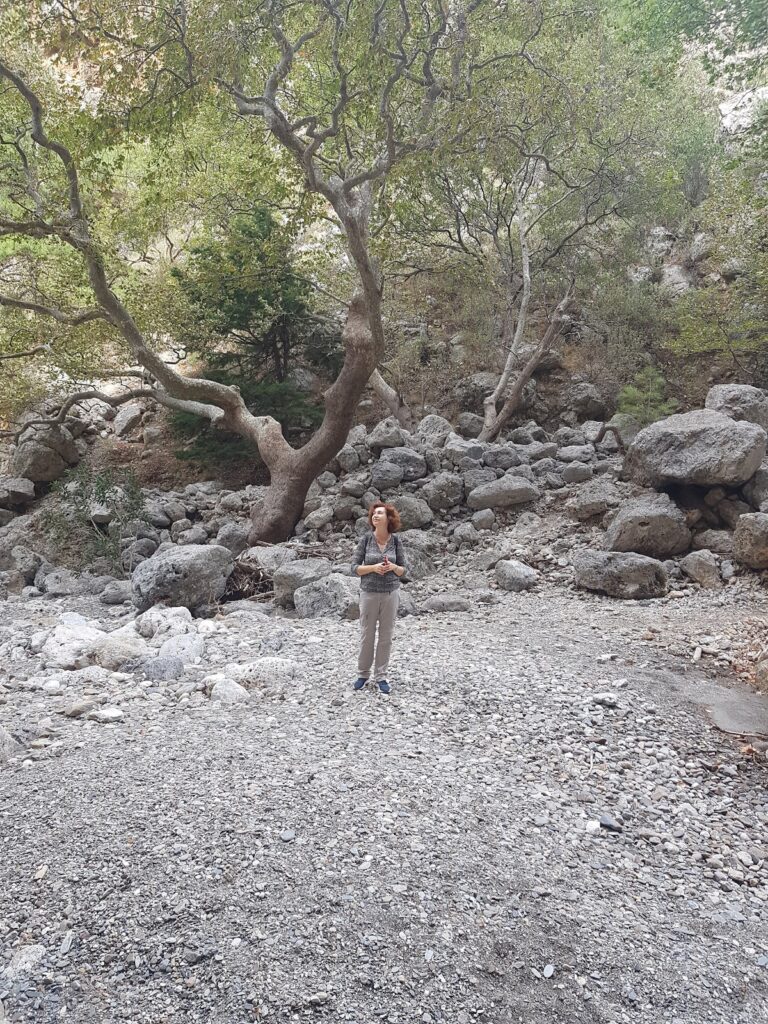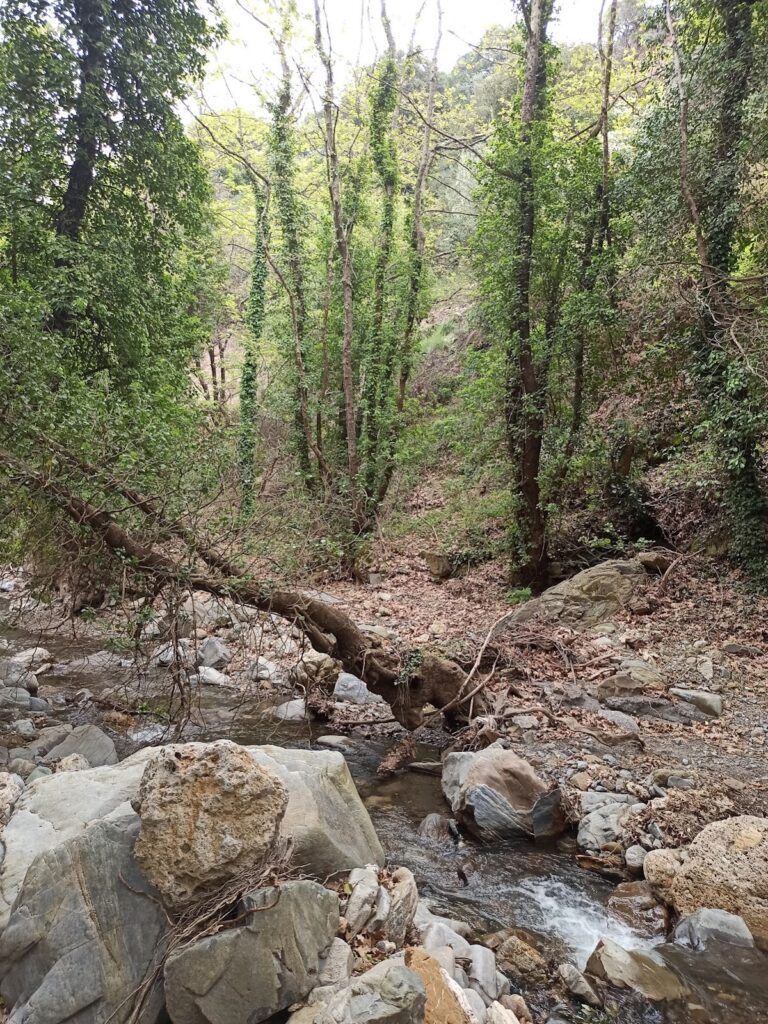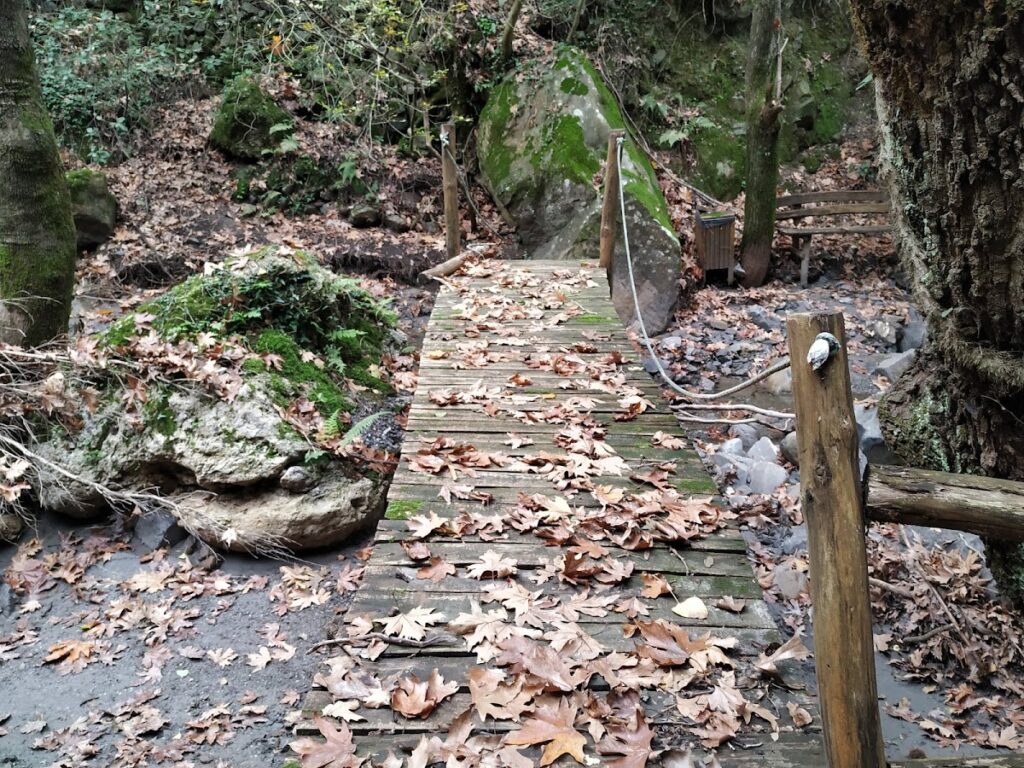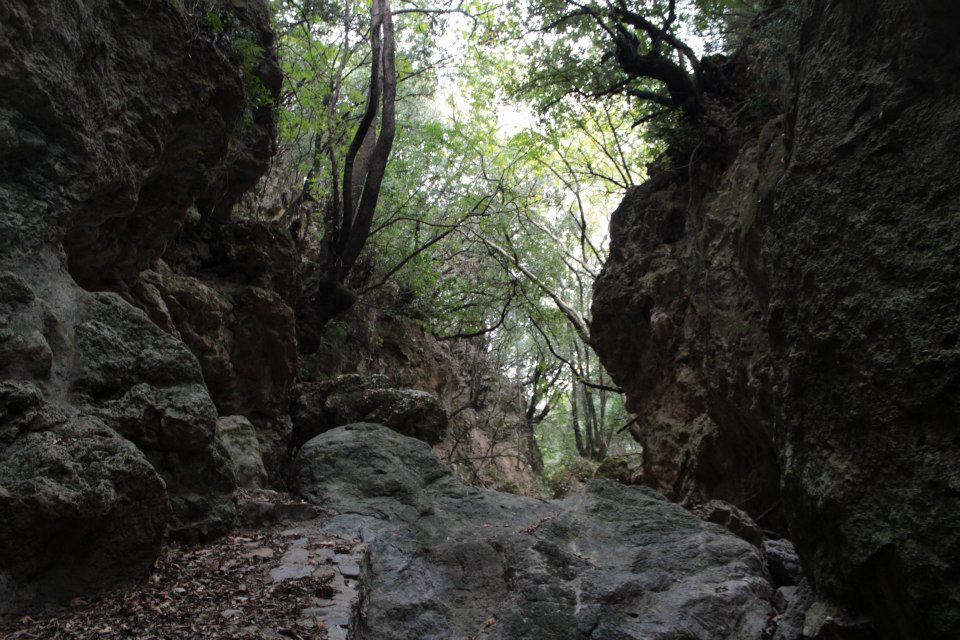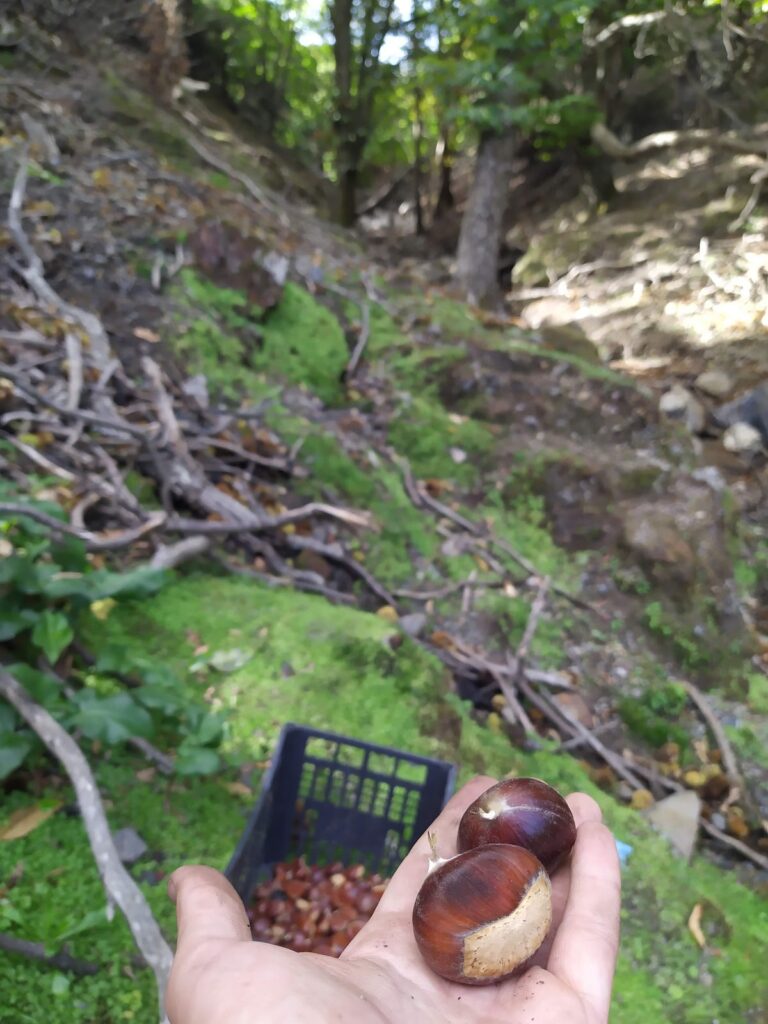Gorges to hike and walk near Asfendhilés, in Chania region
List of Gorges near Asfendhilés
- 2.6 km
- Anydri Gorge
- 3 km
- 2 h
- Hiking
The relatively small yet stunning Anydri gorge is situated to the east of Paleochora, accumulating water from the Asfendiles and Ancient Hyrtakina regions via the Dichalomata stream. The gorge originates from the Anidri village and meanders for approximately 3km between towering cliffs, eventually ending at the picturesque Gialiskari beach.
Trekking through the canyon is straightforward and follows the stream, which typically dries up during the summer. The gorge is sparsely dotted with trees and the rocky walls are not too high, so it’s recommended to bring a hat and sunscreen for protection.
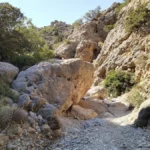
- 4.9 km
- Lihnou Laki Gorge
Located just half an hour above the Lissos archaeological site, in a concealed location known as Lichnou Laki, is a small yet stunning canyon. This gorge is situated in the Selino district, beneath the village of Prodromi, to the south of Chania. It can be accessed via a dirt road that leads south from the village. This petite canyon is lush with greenery and is divided into two distinct sections. The first section is predominantly populated with lentisks, junipers, and oaks, while the second section is blanketed with pine trees, despite a previous fire that ravaged the area.
The gentle riverbed of Lichnou Laki canyon doesn’t feature any waterfalls or other impediments. At the canyon’s most striking point, there is a picturesque rock shelter forming a triangle. Towards the lower exit, a plateau is scattered with ceramic fragments, a clear indication of a former ancient settlement.

- 6.3 km
- Lissos Gorge
- 2 km
- 1 h
- Hiking
The trail linking Sougia to ancient Lissos runs through the grandeur of the Lissos or Skevroto gorge. This lengthy canyon is characterized by its majestic towering walls. However, the path to Lissos only covers a fraction of this route, taking approximately one hour to traverse.
Upon exiting the path on the Lissos side, one encounters the historical remnants of ancient Lissos. Notable landmarks include the Asclepius temple with its floor mosaic, the scattered ruins of the ancient city, tombs, the Roman theatre, and the Panagia and St. Kirikos churches. These churches were erected on the foundation of a previous early Christian church.
Returning to Sougia is possible either by embarking on a boat ride from the picturesque Lissos beach or by retracing the path on foot.

- 9.0 km
- Pelekaniotis Gorge
- 3 km
- 2 h
- Hiking
In the overlooked area of Selino, South Chania, you’ll discover the hidden gem that is the Pelekaniotis River. This river, boasting the highest water flow in Selino, holds such significance that it inspired the name of the Paleochora municipality – Pelekanos. It remains a steady water source throughout the year, culminating in a verdant green valley at the Macherota location. The towering cliffs of the canyon serve as a habitat for numerous birds of prey, providing company for hikers along their journey.
The gorge’s exit can be located by following a dirt road that begins at Grameno beach near Paleochora and traces the river’s west bank. Regrettably, this path crosses a small area littered with rubbish and debris. However, beyond this, the scenery transforms into a lush Cretan landscape. Two kilometres in, the Agios Mamas chapel, adorned with well-preserved frescoes, can be found on the western shore. Despite its significance, the existence of Saint Mammes (Agios Mamas) remains largely unknown, even to locals. Across from Agios Mamas, the old whitewashed chapel of Saint George stands, though it lacks frescoes.
A kilometre further, the dirt road ends at a tank filled with drinkable water. From this point, the gorge can be explored on foot, particularly during summer when the water levels are lower. Adventurous hikers might prefer to visit the Pelekanos Gorge in winter, to witness a 25m high waterfall cascading into the river.
Approximately halfway through the gorge, some of Crete’s most impressive plane trees can be found, with some over 1000 years old and featuring remarkable trunk formations. Much of the canyon is narrow, with sunlight rarely reaching the riverbed. This natural masterpiece is adorned with vertical walls dotted with numerous holm oak trees.

- 9.0 km
- Kandanos Gorge
- 3 km
- 1 h
- Hiking
The Kandanos Gorge is a site of remarkable natural beauty and historical significance, currently threatened by the operations of a large quarry. This gorge was the battlefield for the first armed conflict between locals and governmental forces during World War II. On May 24, 1941, Kandanos residents took up arms against German forces advancing towards their town, a day after the Battle of Floria, where all but one German soldier were killed. In retaliation, the Germans decimated Kandanos and its neighboring villages, executing numerous civilians. To this day, justice for the German war crimes committed in Kandanos and Floria, along with other martyred Cretan villages, remains elusive.
In addition to its historical value, the gorge is teeming with cypress trees and lush vegetation. It’s also traversed by a beautiful stone road leading to Chania, built by locals in the late 1920s. This road stands as a fine example of preindustrial construction.
The upper portion of the Gorge is known as Spina Gorge, named after a nearby village. The lower section, which begins where the gorge intersects the stone road near the Church of Agios Irineos and ends at Anavos, is referred to as Kandanos Gorge. Despite the different names, they are part of the same ravine.
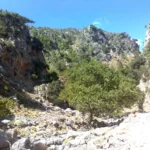
- 9.9 km
- Keratida Gorge
- 3 km
- 2 h
- Hiking
The petite Keratida gorge, filled with pine trees, begins just past the village of Koustogerako. After a challenging two-hour hike, it intersects with the coastal E4 trail that links Sougia and Agia Roumeli. Initially, the route runs alongside the gorge. However, the descent is quite steep and requires caution, as the gorge can be quite unforgiving. The route concludes near the sea, in close proximity to Agios Antonios beach (also known as Charei). From Agios Antonios, it takes an additional two hours to get back to Sougia.
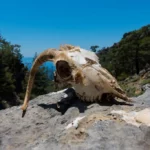
- 11.3 km
- Agia Irini Gorge - Chania
- 7.5 km
- 3 h
- E4 trail
Situated on the western flank of the White Mountains in the Selino province, the Agia Irini gorge owes its name to the nearby village of Agia Irini (Saint Irene), a mere 46 km from Chania.
The trail of Agia Irini Gorge commences just below the Agia Irini village and concludes at the Oasis Taverna. The track, which descends approximately 500 meters, extends for 7.5 km and requires nearly three hours to navigate. It is a well-preserved and predominantly shaded path, embellished with pine trees, plane trees, and oleander bushes.
The journey from the exit of the gorge to the village of Sougia covers about 5 km along a lightly used road with scarce shade. On sweltering days, arranging transportation to Sougia is recommended. The gorge, which is open all year round, is graced with a small river, but certain sections may become inaccessible or dangerous after heavy rain. From April to October, during the tourist season, a nominal fee is collected at the entrance (or exit for those hiking uphill) of the gorge. This fee aids in maintaining the path, collecting trash, and general upkeep to ensure a pleasant experience for all visitors.
The gorge forms part of the European footpath E4. Its southern entrance is positioned 5 kilometers north of Sougia. It is included in the NATURA 2000 protected areas and has been declared a wildlife reserve by the Ministry of Agriculture. The gorge is home to the endangered Cretan ibex, agrimi, and boasts a variety of microenvironments and habitats for an array of wildlife species. The diverse flora, including trees (cypress, pine, maple, plane, oak, holm oak), shrubs, brushwoods, and fine herbs such as dittany, is of significant importance.
The gorge holds immense significance, not only for its rich biodiversity and aesthetic appeal but also for its historical and cultural significance. At the “Polla Spitakia” area within the gorge, rebels found refuge from the Ottomans. This is where the “Fygou” path begins, which served as an escape route from the gorge to the Omalos plateau. The area houses the Byzantine Church of Christ (1358 AD) and the dilapidated church of Saint George (1460 AD). The gorge, second in popularity to Samaria in the Chania prefecture, remains open for a longer duration.
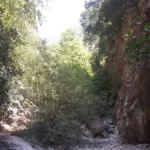
- 11.9 km
- Fygou Gorge
- 3 km
- 1 h
- Hiking
Fygou Gorge, a small yet stunning sub-gorge of the renowned Agia Irini Gorge, is situated near Sougia. This narrow canyon played a significant role in history, serving as an escape route for local rebels to the Sfakia mountains during various revolutions, hence its name ‘Fygou’, meaning escape.
In present times, many trekkers embarking on the Agia Irini Gorge trail, the second most popular gorge in Crete after Samaria, choose to commence their journey from Fygou Gorge. After approximately an hour of walking, they meet the Agia Irini Gorge.
A beautiful path winds through Fygou, weaving between a picturesque cypress and pine grove. An abandoned settlement and a Forest Service outpost can be found at the location known as Polla Spitakia. Near the point where Fygou Gorge meets the Agia Irini Gorge, the historic Hirotrypa cave is located. This site marks a tragic event from 1822 when two local hermits were murdered by the Ottomans.
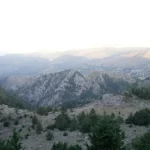
- 14.0 km
- Vavouledo Gorge
- 3 km
- 1 h
- Hiking
The Vavouledo canyon begins approximately 1km east of Hamalevri village, where the Hortes stream flows. A path follows the length of the canyon. Close to Lidiana village, the canyon merges with the Trahinos Gorge, and the combined river continues to the “cosmopolitan” district of Palea Roumata, Arhontika. Here, you’ll find taverns where you can enjoy a meal.
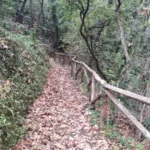
- 14.1 km
- Trahinos Gorge
- 3 km
- 1 h
- Hiking
Located about 35km southwest of Chania city, on the northern slopes of Mount Apopigadi, Palea Roumata is a verdant area. This region is made up of 13 neighborhoods, all part of the same village (Palea Roumata), spread across the slopes. Near the small settlement of Lidiana, the Vavouledo and Trachinos canyons converge, providing an ideal circular route with water until late spring.
The Trahinos Gorge, starting near the Trahinos hamlet, is fairly short but stands as one of Crete’s greenest gorges. Its walls are so narrow that they’re almost unnoticeable from above. The gorge is filled with dense vegetation, often casting shadows over the riverbed. Similar to Vavouledo, the Trahinos Gorge also features a hiking trail.
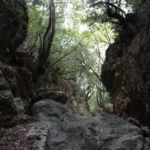
- 14.5 km
- Tripiti Gorge - Chania
- 9 km
- 9 h
- Hiking
Tripiti, the second largest gorge in proximity to Samaria gorge after Klados gorge, can be reached from Omalos plateau via the Gigilos peak trail that intersects Linosseli spring. However, caution is advised due to a precarious pathway where massive landslides could occur, potentially trapping you. It is strongly recommended to be accompanied by an experienced hiker for safety.
As one of Crete’s longest gorges, Tripiti necessitates a two-day journey since no roads lead directly to its entrance. The adventure begins on the first day from Plateau Omalos (elevation 1200 meters), climbing towards the formidable Gigilos peak (2080m). The path crosses the Linoseli spring (1,400m), then ascends to a mountain ridge at 1700m where the Koustogerako trail intersects with the Gigilos trail. From this ridge, the descent to Tripiti gorge’s riverbed commences, which can be reached from Omalos in about three hours. Overnight options include staying on the ridge or continuing slightly further to the dilapidated Tzatzimos sheepfold.
The following day, continue down the trail until it intersects with the river bed at an elevation of 700m. From there, follow the bed to reach the South Cretan Sea at Tripiti beach. The journey from Gigilos to the beach is approximately six hours. The gorge is a spectacle with towering, often cavernous walls (Tripiti’s name derives from the Greek word for caves, “tripes”). It’s not uncommon for hikers to encounter the endangered Cretan ibex amidst the lush flora and pine trees.
Close to Tripiti beach, located at Cape Tripiti, you’ll find a water cistern, a quaint goat pen, and the picturesque chapel of Saint Nicholas. The Tripiti peninsula was once home to the ancient town Pikilasos, a port for the influential town Elyros. If no boat is available for pick-up, a 3-4 hour walk along the E4 trail to the west will take you to the coastal village of Sougia. This trail also passes by the ruins of the Turkish tower of Voukelasi and the chapel of Profitis Ilias (Prophet Elijah). On the feast day of Prophet Elijah (19-20 July), many people from Sougia visit the chapel either by boat or on foot.
For the initial part of the gorge, the riverbed has steep descents requiring canyoneering equipment. Therefore, canyoners can bypass the side trail and traverse the gorge using technical gear in the bed.
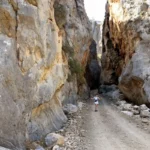
No results available
ResetGorges in other nearby areas
No results available
Reset




